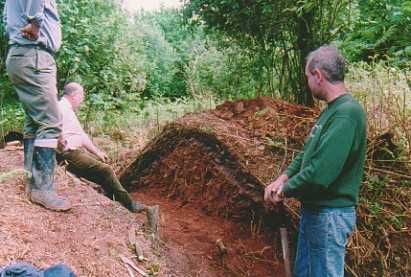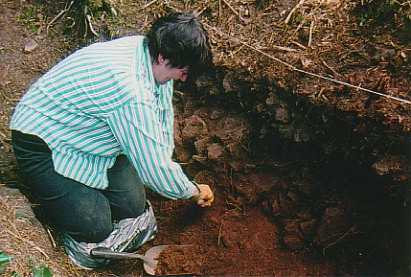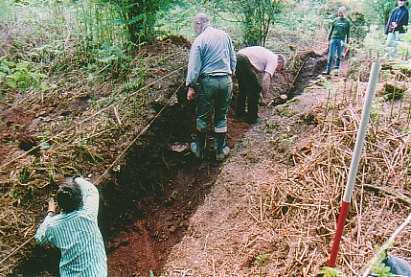
Excavation of a possible prehistoric triple ditch system at The Larches

| Stowe Nine Churches Excavation of a possible prehistoric triple ditch system at The Larches |
| Home | Events & Notices | Recent Discoveries | Publications | Links | How To Join | Contact Us |
The 1972 Excavation
 In December of 1972, Gwen Brown, an Archaeological County Correspondent to the
Department of the Environment, cut a trench 24 metres in length and one metre
wide, across a triple bank and ditches at The Larches, Stowe Nine Churches. The
excavation took place because, despite being a scheduled ancient monument, the
earthworks were due to be flattened and then ploughed in January 1973 (fortunately
this never took place). At the time it was thought that the earthworks were likely
to be part of a medieval deer park, although a civil war earthwork and a rabbit
warren were also considered possibilities.
In December of 1972, Gwen Brown, an Archaeological County Correspondent to the
Department of the Environment, cut a trench 24 metres in length and one metre
wide, across a triple bank and ditches at The Larches, Stowe Nine Churches. The
excavation took place because, despite being a scheduled ancient monument, the
earthworks were due to be flattened and then ploughed in January 1973 (fortunately
this never took place). At the time it was thought that the earthworks were likely
to be part of a medieval deer park, although a civil war earthwork and a rabbit
warren were also considered possibilities.
Mrs Brown employed two students to cut the trench, the section of which was drawn at the scale of one inch to five feet. An accompanying plan showed what was thought to be a hearth protruding from beneath one of the inner banks and in a letter of February 1973, Mrs Brown mentioned that the earthwork was palisaded with large post holes in the ditches. No dating evidence was found during this excavation and although the section drawing survives, there was apparently no written account. Presumably because of its supposed imminent destruction, the original trench was never backfilled.
Linear Earthworks
In the 30 years that followed Gwen Brown's excavation, our understanding of
the range, date and distribution of linear earthworks has greatly increased. Several
examples of single bank and ditch systems survive as upstanding earthworks on
the Wessex chalk and these have been increasingly associated with territorial
division during the late Bronze Age and Early Iron Age. Aerial survey in the Midlands
had revealed many new examples some of which had multiple banks and ditches similar
to those at The Larches.
The 2001 Excavation
 When
it was recently noted that Gwen Browns trench was still open, a re-examination
of the earthwork was proposed given the rarity of such a well preserved monument.
It was proposed to re-cut one of the sections, then clean the bottom of the trench
to determine whether the ditch profiles had been correctly established and re-examine
the evidence for the hearth and the postholes. Finally, it was hoped to establish
the how destructive the growth of bracken had been to the monument.
When
it was recently noted that Gwen Browns trench was still open, a re-examination
of the earthwork was proposed given the rarity of such a well preserved monument.
It was proposed to re-cut one of the sections, then clean the bottom of the trench
to determine whether the ditch profiles had been correctly established and re-examine
the evidence for the hearth and the postholes. Finally, it was hoped to establish
the how destructive the growth of bracken had been to the monument.
In June
of 2001 the 1972 excavation was cleared of undergrowth and the section cut back
30cms. Once again, no dating evidence was found within the ditches and banks,
although a single piece of worked flint was sealed beneath one of the banks (well
spotted Gill). Although incomplete, the piece appears to be a broken blade with
several blade scars on its dorsal face, suggestive of early Neolithic origins
at the latest. Re-cutting the section confirmed that the inner bank was in fact
composed of two banks with a shallow depression between them. This suggests that
they were simultaneously constructed from the up-cast of their respective quarry
ditches. The southernmost outer bank is a later addition although it is over twice
the height of the inner ditches. If one accepts that this earthwork was de-marking
some sort of territorial boundary then the southern bank could be seen as a re-statement
of the boundary in such a way as to make it more visible. The northernmost bank
is the least pronounced and may well have been constructed from a fourth ditch
that lies outside the scheduled area. There was no surviving evidence of the hearth
shown on the 1973 section or of the postholes mentioned in correspondence.
 One rather obvious and troubling feature that was revealed by this excavation
was the extent to which the root systems of bracken had penetrated the earthwork.
These were found throughout the excavated area completely destroying the upper
levels of the earthwork. Even if there had been a hearth surviving beneath the
bank, carbon dating would have been impossible since any charcoal associated with
it would have been contaminated by root penetration. A much more detailed study
of the effects of bracken on archaeological monuments is currently being carried
out on Dartmoor . By measuring the root systems associated with each bracken plant
it has been calculated that the amount of root penetration below ground is roughly
equivalent to the amount of plant growth on the surface in high summer!
One rather obvious and troubling feature that was revealed by this excavation
was the extent to which the root systems of bracken had penetrated the earthwork.
These were found throughout the excavated area completely destroying the upper
levels of the earthwork. Even if there had been a hearth surviving beneath the
bank, carbon dating would have been impossible since any charcoal associated with
it would have been contaminated by root penetration. A much more detailed study
of the effects of bracken on archaeological monuments is currently being carried
out on Dartmoor . By measuring the root systems associated with each bracken plant
it has been calculated that the amount of root penetration below ground is roughly
equivalent to the amount of plant growth on the surface in high summer!
Acknowledgements
I would like to thank the land owner, Mrs Starmer and her tenant Mr Franks
for allowing the excavation to take place. Many thanks are also due to Graham
Cadman, who helped to organise this excavation, dealing with all the bureaucratic
niceties associated with the excavation of a scheduled ancient monument. English
Heritage were kind enough to pay for the cost of surveying the trench by Northamptonshire
Archaeology, as well as agreeing to consider the additional cost of backfilling
the excavation. The heroes of the piece were the NAS members who did the digging,
Dave and Gerry Mico, Ian Barrie, Steven Hollowell and Gill Johnston. Volunteers
to help with the backfilling, later this year, would be most welcome.